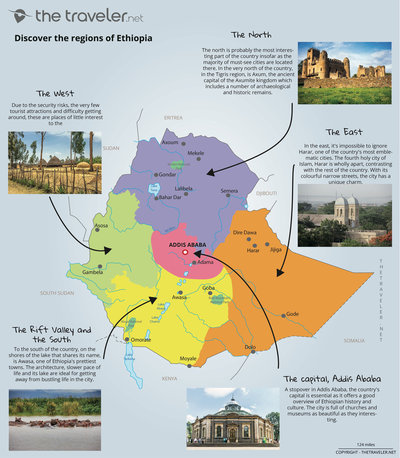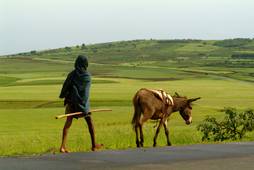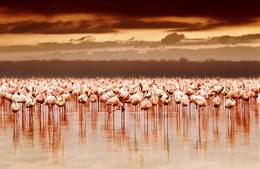Plan an amazing trip to Ethiopia
On the horn of Africa, to the east of the continent, Ethiopia is a fascinating and little known country which will astonish you with the beauty of its landscape and impress you with the richness of its remarkably well preserved cultural and architectural heritage. Bisected by the great Rift Valley, "cradle of civilisation" where the remains of 'Lucy' were found, Ethiopia is composed of verdant plains, steep summits, stretches of deserts, great lakes, impressive waterfalls and deep canyons. Most of the country is covered by the high plateau at over 2,000 metres altitude, of which Ras Dachan is the highest point. The numerous national parks allow you to observe the particularly rich flora and fauna of the African plains and many species of birds. The Simien National Park, a UNESCO world heritage site, is breathtakingly beautiful. Its stunning landscape of cliffs, precipices and rugged peaks shelters endemic, rare and protected species such as the Gelada baboon and Ethiopian wolves. Rich in ancient history, Ethiopia delights visitors with its monuments, ruins and UNESCO world heritage sites. Don't miss Aksoum, with its great stela, centre of the ancient Aksoumite kingdom or Gondar, the former capital of Ethiopia, with its medieval castles and old churches. Labilela's extraordinary medieval churches carved into the red rocks of the high plateau, with ornately painted walls are an important place of pilgrimage for Orthodox Christians. The churches and monasteries built on the islands of Lake Tana also testify to the country's Christian past. A visit to Addis Ababa with its cathedral and many museums will complete a trip to Ethiopia, a country that you will love to discover and which is increasingly open to tourism.

Sonia's tips, Journalist and Ethiopia expert
Best time to go to Ethiopia
Choose to visit Ethiopia between October and March. The weather will be drier and you will enjoy temperatures of around 25°C during the day. Avoid June and July - the rainy season.
What to see and what to do in Ethiopia
Sonia answers your most frequently asked questions
As with adults, children will be delighted to discover Ethiopia. There are numerous species of animals, breathtakingly beautiful national parks and characterful historic towns... children won't have the time to get bored.
Ethiopians are very devout and don't miss any opportunity to celebrate. In January, Timkat, the equivalent of the Epiphany and the most important religious celebration is observed. Although Timkat is celebrated throughout the country, it is in Gobar and Lalibela that the celebrations are most spectacular. For three days, thousands of faithful parade through the streets singing and dancing. It's magical! Another important event is celebrated at the end of September - Meskel, celebration of the True Cross. During the celebrations, the faithful commemorate the discovery in 326 AD of the cross on which Christ was crucified. On this occasion, huge cross shaped pyres are adorned with yellow flowers and set alight in Ethiopian villages. The largest is set alight in the centre of the capital, Addis Ababa. This great celebration is an opportunity for family and friends to gather together.
Ethiopia is full of treasures:
In the capital, Addis Ababa, there is the beautiful archaeological museum where you can see the remains of "Lucy', discovered in 1974. There is the orthodox cathedral of the Holy Trinity, the open air market, Mount Entoto and the Kiddus Raguel church from which there is magnificent panorama of the town.
The 15th century imperial city of Gondar and the Fasilidas Palace should not be missed either. At 2,600 metres altitude, the medieval city of Lalibela is classified as a UNESCO world heritage site. This holy city for Orthodox Christians is an archiectural treasure of eleven monolithic churches carved into the rocks and connected by tunnels dug into the cliffs.
Other must-sees include: Bete Gyorgis, a monolithic church sculpted into the shape of a Greek cross; In Godjam Province, the immense Lake Tana which can be crossed in papyrus canoes known as 'tankwas.' The lake has thirty islands planted with lemon trees and coffee plantations, overlooked by monasteries with painted murals (Uma Kidane Mehret and Betre Maryam), impressive waterfalls (45 metres high), the 400 metre wide Blue Nile and the massif Simien volcanic mountains furrowed by deep gorges.
To the north, discover Axoum, the ancient capital of the Queen of Sheba's empire, with its temples, palaces, garden of stelas, tombs and obelisks. Ethiopia has 67 volcanoes spread over the Rift Valley fault. Hikes are organised close to Dallol's active sulphurous green crater (163 metres) and Erta Ale's (613 metres) red lava lake, in the Danakil desert with its geysers and hot springs. You can also take the dazzlingly beautiful hike to see the salt mine caravans.
To the east, in the middle of coffee plantations, is the fortified medieval town of Harar, with its narrow streets, the palace, its markets and the house of Arthur Rimbaud.
Close to the Kenyan border in the south, in the Omo Valley, you can meet semi-nomadic, animist ethnic communities, in their beehive like huts set in a landscape of lakes and forests.
In Mago National Park, you will find the Mursis, whose women wear impressive lip plates, the Hamer people who scarify their bodies, the Karo who adorn their bodies with white paint and wear headdresses made of plant fibres, and the Daasanach people.
Photo safaris can be taken in the Aouche and Nechisar national parks where you will see crocodiles, wolves, antelopes, monkeys, birds and nyalas, and in Abiata Shallas Park, hot springs and pink flamingoes.
Walking and hiking through the breathtaking landscape will leave you with indelible memories. Then there's encountering the locals and visiting extravagant monuments on foot, 4x4, on horseback or by boat.
- The abundant national parks are magnificent!
- The rich cultural heritage.
- The diversity of flora and fauna.
- Stunning landscapes
- Discovering a unique, rich and extremely interesting culture.
It's impossible to go to Ethiopia without trying the local food - it really is an essential part of any visit. The most representative dish is 'injera', a pancake made of teff flour, an indigenous grass which grows only in this part of Africa. Injera is served with a variety of sauces which will suit vegetarians or meat eaters. Be sure to take part in a coffee ceremony, a very important moment in local life. As well as being considered one of the best coffees in the world, coffee allows Ethiopians gather among friends and family during the day. Coffee tasting is accompanied by a range of traditional rituals and customs.
If there's a country full of beautiful souvenirs, it's Ethiopia. You will find cooking utensils, wooden sculptures and beautiful jewellery for all tastes. As for clothes, there is the traditional dress (for women and men) or just a simple traditional scarf. And leave a little room in your bags for some traditional Ethiopian coffee, with its global reputation for excellence.
Ethiopia is generally considered to be safe. Nevertheless, as is always the case for tourists, you should be careful not to attract the attention of thieves. Give an appearance of confidence in yourself and don't carry large sums of money with you (its best to keep most of your money in your hotel room) etc. Due to political conflict, some areas of the country should be avoided. Specifically, areas along the border should be avoided, such as the Eritrean border in the Danakil Depression and the area close to Somalia.
- Extremely poorly maintained roads which create traffic problems in the country.
- Areas of the country which are not possible to visit for political and social reasons.


























